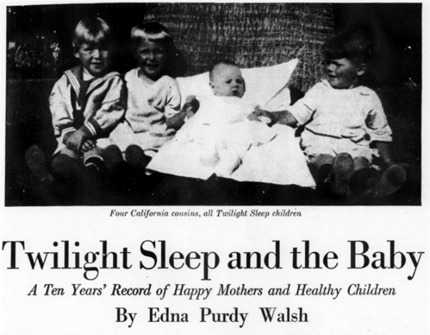Article Summary by Jerika Sanderson and Heather A. Love
This article investigates the depiction of twilight sleep in McClure’s Magazine. Twilight sleep was a drug cocktail and medical procedure popularized during the mid-1910s in the United States as a way to reduce or eliminate women’s pain during childbirth; it became an important symbol of agency among women who advocated for access despite American doctors’ hesitancy. In the 1910s and 1920s, McClure’s Magazine published several stories that featured the experiences of women who had given birth under twilight sleep themselves. In this article, we investigate how McClure’s writers drew on the textual and visual rhetoric of the eugenics movement to encourage white, middle- and upper-class American women to give birth to more (and “healthier”) children by using twilight sleep. Across McClure’s articles, women who use twilight sleep are glamourized as “scientific mothers” who mobilize the latest medical and scientific information to achieve positive labor experiences. To emphasize these arguments, the articles incorporate photographs of smiling mothers and twilight sleep babies to visually reinforce twilight sleep’s association with positive mental and physical health outcomes. Importantly, McClure’s articles connected twilight sleep with success in Better Babies competitions—eugenics-based events that assessed the health and development of babies. As this analysis demonstrates, proponents of twilight sleep engaged in the same rhetorical strategies as the concurrent eugenics movement, cultivating a broader cultural narrative of women’s empowerment as a strategy to elicit public support for the procedure.

Read the full article on the Medical Humanities journal website.
 Jerika Sanderson (she/her) is a PhD candidate in English at the University of Waterloo. Her research is supported by the Social Sciences and Humanities Research Council, and investigates 21st-century biotechnologies across the media, literature, and popular culture. She has worked on several interdisciplinary projects, including as a research assistant for a project investigating how 20th-century obstetric developments were communicated in magazines and medical texts.
Jerika Sanderson (she/her) is a PhD candidate in English at the University of Waterloo. Her research is supported by the Social Sciences and Humanities Research Council, and investigates 21st-century biotechnologies across the media, literature, and popular culture. She has worked on several interdisciplinary projects, including as a research assistant for a project investigating how 20th-century obstetric developments were communicated in magazines and medical texts.
 Heather A. Love (she/her) is Assistant Professor of English at the University of Waterloo (Ontario, Canada), where her research and teaching focus on topics related to early twentieth-century literature and culture, technology and health, and STEM communication. She is author of Cybernetic Aesthetics: Modernist Networks of Information and Data (2023, Cambridge University Press), and PI for a Social Sciences and Humanities Council of Canada-funded project titled “Techno-Mediated Maternity.” Her work has appeared in Modernism/modernity, the Journal of Modern Literature, Feminist Modernist Studies, New Literary History, and the IEEE Technology and Society Magazine.
Heather A. Love (she/her) is Assistant Professor of English at the University of Waterloo (Ontario, Canada), where her research and teaching focus on topics related to early twentieth-century literature and culture, technology and health, and STEM communication. She is author of Cybernetic Aesthetics: Modernist Networks of Information and Data (2023, Cambridge University Press), and PI for a Social Sciences and Humanities Council of Canada-funded project titled “Techno-Mediated Maternity.” Her work has appeared in Modernism/modernity, the Journal of Modern Literature, Feminist Modernist Studies, New Literary History, and the IEEE Technology and Society Magazine.